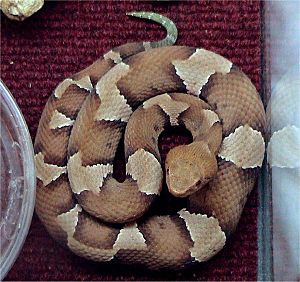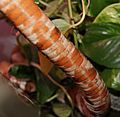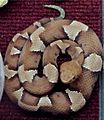Broad-banded copperhead facts for kids
Quick facts for kids Agkistrodon contortrix laticinctus |
|
|---|---|
 |
|
| Scientific classification |
|
| Kingdom: | Animalia |
| Phylum: | Chordata |
| Class: | Reptilia |
| Order: | Squamata |
| Suborder: | Serpentes |
| Family: | Viperidae |
| Genus: | Agkistrodon |
| Species: | |
| Subspecies: |
A. c. laticinctus
|
| Trinomial name | |
| Agkistrodon contortrix laticinctus Gloyd & Conant, 1934
|
|
| Synonyms | |
|
|
The broad-banded copperhead, also called the Texas copperhead, is a type of venomous pit viper. Its scientific name is Agkistrodon laticinctus. This snake lives in the southern United States. You can find it in Kansas, Oklahoma, and all across central Texas. It used to be thought of as a subspecies of the Agkistrodon contortrix snake.
Contents
What Does the Broad-Banded Copperhead Look Like?
This snake is usually a light tan color. It has wide, dark brown bands across its body. These wide bands are why it's called the "broad-banded" copperhead. The snake's actual color can change depending on where it lives. It might be reddish-brown or grayish-brown.
It can be tricky to tell this snake apart from other copperheads.
- The Trans-Pecos copperhead (A. c. pictigaster) looks very similar. The main difference is that the Trans-Pecos copperhead often has a fancy black and white pattern on its belly. The broad-banded copperhead usually has a plain white belly.
- The southern copperhead (A. c. contortrix) also lives in some of the same areas. The southern copperhead usually has bands that get narrower in the middle, like an hourglass. The broad-banded copperhead's bands stay wide all the way across its back.
Broad-banded copperheads usually grow to be about 20 to 36 inches (50 to 90 cm) long. When they are young, all Agkistrodon snakes have bright green-yellow tips on their tails. Scientists think they use this bright tail tip to trick small prey into coming closer. The tail color fades to gray or brown when the snake is about a year old.
Names for the Broad-Banded Copperhead
People call this snake by many different names. Some common names include:
- Broad-banded copperhead
- Copperhead moccasin
- Copperhead snake
- Dry-land moccasin
- Highland moccasin
- Moccasin
- Rattlesnake pilot
- Red eye
- Texas copperhead
- Thunder snake
Where Does the Broad-Banded Copperhead Live?
The broad-banded copperhead, Agkistrodon laticinctus, lives in a specific area. This area is between 97 and 99 degrees west longitude. It stretches from Central Texas up to the southern borders of Kansas and Oklahoma.
How Does the Broad-Banded Copperhead Behave?
This snake likes to keep to itself and is mostly active at night. It prefers lightly wooded areas. These places usually have lots of leaves and branches on the ground where the snake can hide. It also likes to be near a constant source of water. This snake usually stays away from places where many humans live.
The broad-banded copperhead is an ambush predator. This means it waits for its prey to come close, then strikes quickly. It eats many different animals, including:
Young copperheads especially enjoy eating insects, such as cicadas and caterpillars.
These snakes give birth to live young. They are ovoviviparous, which means the eggs hatch inside the mother's body. The mother then gives birth to up to eight baby snakes in the early fall.
Understanding Broad-Banded Copperhead Venom
Like most pit vipers, the broad-banded copperhead has hemotoxic venom. This type of venom affects blood and tissues. The snake delivers its venom using hollow, hinged fangs located at the front of its mouth. These fangs work like tiny hypodermic needles. They inject the venom in one quick strike.
A bite from a copperhead is usually not life-threatening for a healthy adult. However, it can cause:
- Swelling in the bitten area
- Tissue damage (called necrosis)
- Severe pain
Any bite from a venomous snake should be taken seriously. You should always get medical help right away. There isn't a specific antivenom made just for copperheads. But, a medicine called CroFab can be used for serious bites. CroFab is made using venom from the cottonmouth snake (Agkistrodon piscivorus), which is a close relative.
- Agkistrodon contortrix at the TIGR Reptile Database. Accessed 7 December 2007.
Images for kids










